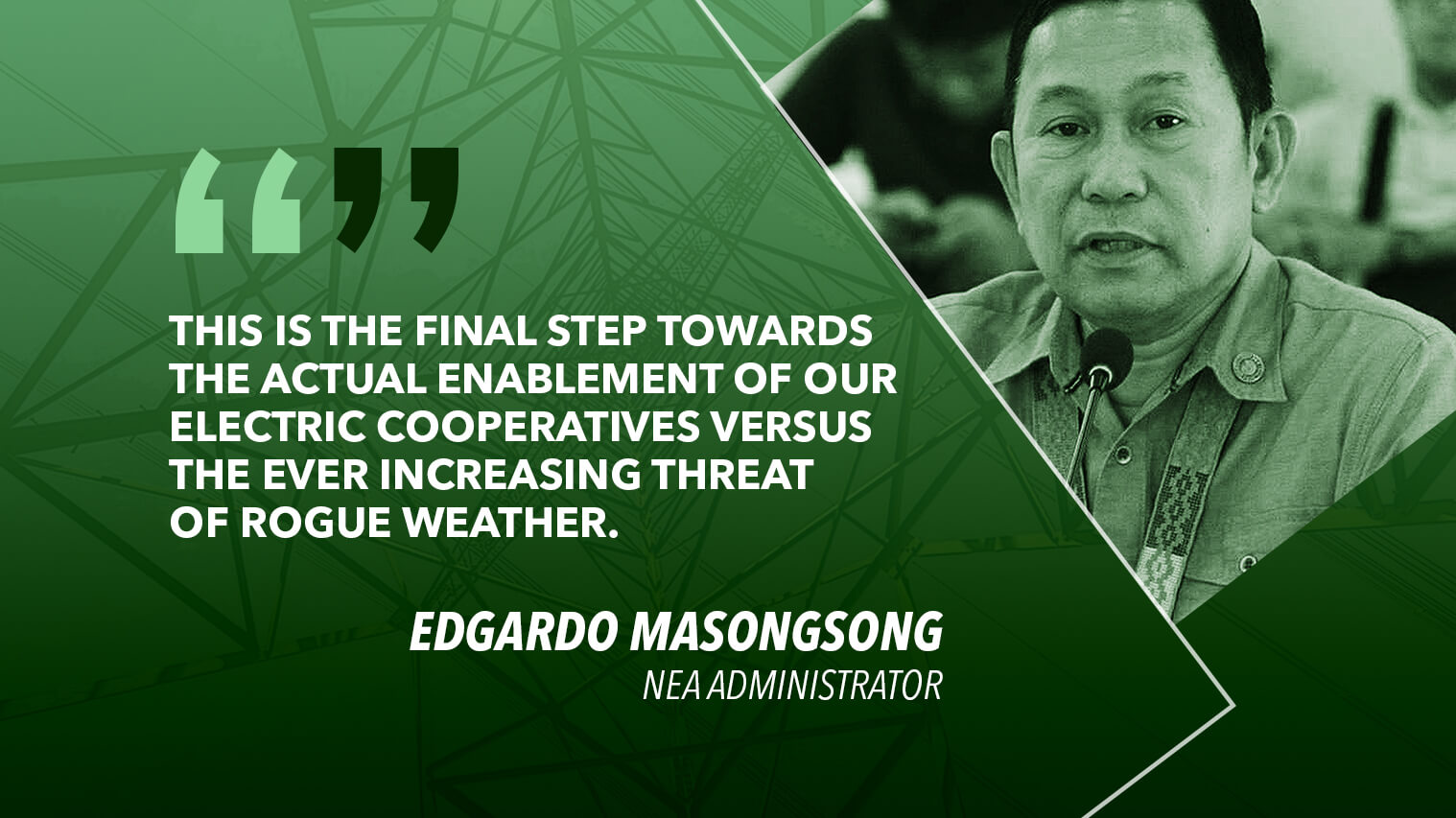State-run National Electrification Administration (NEA) has issued the implementing rules and regulations (IRR) of Republic Act No. 11039, also known as the “Electric Cooperatives Emergency and Resiliency Fund (ECERF) Act.”
The 15-page IRR was approved and signed by NEA Administrator Edgardo Masongsong on December 14, 2018. It has already been registered with the Office of the National Administrative Register at the University of the Philippines Law Center and will take effect 15 days after its publication in a newspaper of general circulation.
“This is the final step towards the actual enablement of our electric cooperatives versus the ever increasing threat of rogue weather, and a timely capacitation towards mitigation, adaptation and resiliency. Aside from being a feather in the cap of the legislative branch, this is also a testament that our lawmakers are responsive to climate realities,” Masongsong said.
The IRR provides guidelines for the implementation of RA 11039 enacted in June last year, which seeks an orderly and continuing means of financial assistance to electric cooperatives (ECs) in the form of grants for the immediate restoration or rehabilitation of damaged infrastructure after a fortuitous event or force majeure.
The rules apply to all ECs in the country.
Under the law, the ECERF will be managed and administered by the NEA. It will have an initial amount of P750 million to be taken from the National Disaster Risk Reduction and Management Council (NDRRMC) Fund and will be immediately released to the NEA Quick Response Fund for proper release to qualified ECs.
“Aside from being a feather in the cap of the legislative branch, this is also a testament that our lawmakers are responsive to climate realities.”
Section 8 of the IRR states that the “concept of ‘Build Back Better’ shall be integrated in the recovery, rehabilitation and reconstruction phases after a disaster to increase the resilience of the affected ECs’ infrastructure.”
After 50 percent utilization of the fund, the NEA shall seek for the allocation of a supplementary budget from the NDRRMC Fund which is equivalent to at least the initial fund allocation, subject to the approval of the President.
It also authorizes the NEA to deduct engineering and administrative overhead expenses which are limited to: pre-construction activities, construction project management, testing and quality control, acquisition, rehabilitation and repair of related equipment and parts, and contingencies in relation to pre-construction activities.
Meanwhile, the IRR states that donations in the form of funds, whether local or international, intended for the restoration and rehabilitation of the ECs’ damaged infrastructure shall be received by the NEA, subject to existing auditing rules and regulations.
“The NEA shall designate an exclusive account for such donations and shall be utilized exclusively for such restoration or rehabilitation,” Section 9 of the IRR states.
The IRR provides guidelines for the implementation of RA 11039 enacted in June last year, which seeks an orderly and continuing means of financial assistance to ECs in the form of grants.
The NEA shall also receive donations in the form of materials and equipment that will be directly delivered to the designated recipient EC or ECs. In case the donor did not designate a recipient, the NEA shall have the discretion to choose among the affected ECs taking into consideration the severity of the damage.
The IRR also outlines the powers and functions of the NEA in addition to its current mandate, which include formulating policies and coordinating the implementation of all activities of the ECs relative to emergency and resiliency management.
It also tackles the responsibilities of the ECs in addition to their mandate to implement the rural electrification program. These include ensuring the preparedness and mitigation measures to protect the adverse impact of any fortuitous event or force majeure.
The ECs shall also ascertain the ability of their manpower to undertake emergency response for the immediate restoration or rehabilitation of their damaged infrastructure after a fortuitous event or force majeure.
In addition, the ECs are required to submit to the NEA their respective comprehensive and integrated disaster management programs, such as vulnerability and risk assessments, resiliency compliance plans, and emergency response plans.
Failure to submit said assessment and plans to the NEA shall bar the ECs from accessing the ECERF.
Moreover, Section 12 of the IRR states that NEA, in addition to its present restructuring plan, shall establish its Disaster Risk Reduction and Management Department with the following responsibilities:
- Assess, develop and implement disaster risk reduction management plan covering preparedness, damage assessment, rehabilitation and restoration of network and non-network facilities of ECs;
- Provide technical support and assistance to ECs in the preparation and implementation of disaster risk reduction and management plans;
- Supervise and coordinate rehabilitation and restoration activities in the event of a major disaster or after the occurrence of a fortuitous event or force majeure;
- Ensure that the NEA and the ECs are prepared to response and manage any type of crisis whether man-made or natural;
- Directly monitor the strict implementation of the objectives and provisions of the ECERF Act.


